Research
Injuries and poisoning in children
Unintentional injuries are emerging as an important, largely preventable, growing public health problem in children in developing countries: the Eastern Mediterranean Region has the second highest estimated mortality rate in children under-five per 100 000 population in the world, after the African region.
Together with road traffic injuries, drowning, burns and falls, poisoning is a major contributor to the burden of injury in children. In the group under 20 years old, children under-five have the highest mortality rates related to unintentional poisoning per 100 000 population in the Eastern Mediterranean Region. While children under the age of one year have the highest rates of fatal poisoning, non-fatal poisoning is more common in the age group 1 to 4 years old.
Exposures occur much more frequently in children below 5 years old than older children, because of their curiosity to explore the environment and tendency to put things in their mouth, their unawareness of the risks, and play patterns. Data on morbidity are often limited to those collected at poison control centres. It is expected that for every death from injury in children, a substantial number of non-fatal injuries, outpatient visits and hospital admissions are likely to occur.
World report on child injury prevention
Research on poisoning in children
The Regional office for the Eastern Mediterranean has coordinated initial research work on poisoning in children to develop standard clinical guidelines for the outpatient management of children with poisoning at primary health care facilities.
Work has focused on poisoning from hydrocarbons and organophosphates / carbamates.
Rationale
Among acute poisonings in children, unintentional exposure to hydrocarbons—especially kerosene—is frequently reported. Organophosphates and carbamates are among the most frequently used insecticides, and children under-five account for a large proportion of acute, unintentional poisonings from these agents.
Children are more vulnerable to the effects of pesticides and may absorb relatively more chemical due to their larger surface area to body weight ratio. Thus, a smaller dose is required to cause symptoms in children than in adults.
Children often need to be admitted and managed as inpatients. There is lack of clinical algorithms for use in settings with limited resources to identify children who are likely to have a more severe outcome based only on few clinical signs and symptoms.
Derivation of the clinical algorithm
The Regional office has collaborated in two prospective studies conducted to identify clinical predictors of severity of unintentional poisoning from hydrocarbons and organophosphates, respectively, in children below five years of age.
The studies have identified three clinical signs in children exposed to hydrocarbons (sensitivity 98% and specificity 42%) and two clinical signs in children exposed to organophosphates / carbamates (sensitivity 100% and specificity 77%) that, if present within two hours of exposure, may help differentiate between children requiring higher level resources (referral) from those not requiring them. These findings need validation.
The studies were carried out at the Poison Control Centre of Ain Shams University Hospitals, Cairo, Egypt, in 2004-2005. The samples included 256 children under-five with exposure to hydrocarbons and 95 children under-five with exposure to organophosphates and carbamates, respectively.
The results of the hydrocarbon study “A clinical decision rule for triage of children under 5 years of age with hydrocarbon (kerosene) aspiration in developing countries”, by the WHO EMRO Pediatric Hydrocarbon Study Group, have been published in Clinical Toxicology, Volume 46, Issue 3 March 2008, pages 222 – 229.
The results of the organophosphate / carbamate study "A clinical decision aid for triage of children under five years of age with organophosphate or carbamate insecticide exposure in developing countries”, by the WHO EMRO Pediatric Insecticide Study Group have been published in the Annals of Emergency Medicine, Volume 52, Issue 6, December 2008, pages 617-622.
Validation of the clinical algorithm
The clinical algorithms derived in the Egypt study need to be validated prospectively in other settings in other countries with a different prevalence and spectrum of the poisoning conditions.
A pilot validation study on the clinical algorithm on hydrocarbon poisoning is currently being conducted at Allied Hospital / Punjab Medical College, Faisalabad, Pakistan.
Surveys and follow-up
WHO has developed a health facility survey tool and an approach to follow-up after training in IMCI (Integrated management of child health), which the Regional office has adapted and used in the Region.
IMCI health facility surveys in the Region
Health facility survey manual
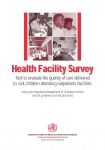 WHO has developed a health facility survey manual to assist country programme managers in evaluating the quality of care delivered to sick children attending outpatient facilities (using the IMCI clinical guidelines as best practices).
WHO has developed a health facility survey manual to assist country programme managers in evaluating the quality of care delivered to sick children attending outpatient facilities (using the IMCI clinical guidelines as best practices).
The Regional Office for the Eastern Mediterranean (EMRO) has revised the methodology for use in the Region, taking into consideration: a) previous, extensive experience in the conduct of similar health facility surveys on diarrhoeal diseases and acute respiratory infections; and b) needs for adaptation to the situation in countries in the Region.
Major changes in the regional adaptation concern the collection of:
- Information on not only whether key clinical management tasks are performed but also whether they are performed correctly;
- Additional information on items of particular relevance to a particular country setting (e.g., out-of-pocket health expenditure, relationship of caretakers’ report of breathing signs with pneumonia and care-seeking, etc.);
- Qualitative information, as an additional resource for data analysis to assist in the interpretation of the quantitative data. This information, collected using a semi-structured form, includes observations of the survey team on issues mostly related to health systems support, such as organization of work at the facility, medicines (procurement, uninterrupted supply, etc.), referral, utilization of services, routine reporting and constraints to the implementation of the IMCI strategy.
The adapted survey forms are available from the reports on the IMCI health facility surveys conducted in the Region.
The Regional office has developed additional tools to assist in preparing for the survey, collecting the required data and information for planning. The guidelines “Survey procedures and question-by-question explanations” have been thoroughly revised to include more examples and details to meet the needs in the field.
The survey instruments enable the collection of health facility data on child health service indicators and, together with data on outcome indicators from other sources, are useful to monitor progress towards the achievement of the child health-related Millennium Development Goals.
Follow-up visits
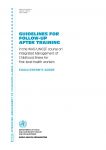 WHO has developed a standard methodology to conduct follow-up visits after IMCI (Integrated management of child health) training.
WHO has developed a standard methodology to conduct follow-up visits after IMCI (Integrated management of child health) training.
These in-depth visits have the objective to reinforce the skills of health providers trained in IMCI, review those health system elements required to support them in the delivery of quality outpatient child health services according to the IMCI strategy, assess caretaker satisfaction with the care received and identify and help solve problems faced by the trained providers.
Staff who conduct follow-up visits receive a standard training on the follow-up methodology and gather information using standard forms.
As such, the follow-up visits are at the same time an integral part of training, a strong supervisory tool and a means of collecting information on health provider performance after training. This last aspect has been used in the Region to assist in monitoring progress in provider performance, as an intermediate step towards measuring final outcome indicators.
Follow-up visits do not replace surveys but may be conducted more frequently to help guide planning and managers’ decisions.
Guidelines for follow-up after training
IMCI health facility surveys in the Region
The Regional Office has directly collaborated and been involved in the planning and conduct of health facility surveys on the quality of outpatient child health services in selected countries in the Region.
Morocco
National Health Facility Survey on the Quality of Outpatient Primary Child Health Care Services – IMCI health facility survey, Morocco, October-December 2007
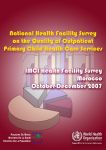 |
Report (pdf, 5.83 Mb) |
Sudan
National Health Facility Survey on the Quality of Outpatient Primary Child Health Care Services – IMCI health facility survey, Sudan, March-April 2003
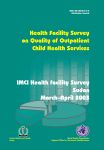 |
Report (pdf 4.08 Mb) |
 |
Booklet with graphics (pdf 668 KB) |
Egypt
Health Facility Survey on Outpatient Child Care (IMCI) Services, Egypt, March 2002
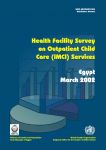 |
Report (pdf 325 kb) |
 |
Booklet with graphics (pdf 660 kb) |
External resources
United Nations Children’s Fund (UNICEF) - Multiple Indicator Cluster Surveys (MICS)
Country reports, MICS tools and other useful information.
“Countdown to 2015” country profiles
Information on key maternal, neonatal and child interventions, with profiles for 75 countries.
Measure DHS – Demographic and health surveys
Information on hundreds of Demographic and Health Surveys (DHS), other quantitative surveys and qualitative surveys (http://www.measuredhs.com/).
Indicators
What is an indicator?
A programme indicator in public health is basically a number, proportion, percentage or rate that helps measure ( “indicate”) the extent to which planned activities have been conducted (process and output indicators) and programme achievements have been made (outcome and impact indicators).
There is a logical ”flow” of indicators from inputs through impact. Plans should always include clear and measurable indicators that go beyond monitoring only the “process” to include also the “outcome”, that is what the intervention should lead to—as this is the main reason why certain activities have originally been planned. For example, a plan includes training courses for health providers on the management of a sick child. This is done: -> to improve health providers’ case management skills of sick children -> to improve how children are managed (outcome) -> to improve child health, e.g. reducing child deaths (impact).
Type of indicators
Input indicators
These indicators refer to the resources needed for the implementation of an activity or intervention. Policies, human resources, materials, financial resources are examples of input indicators.
Example: inputs to conduct a training course may include facilitators, training materials, funds.
Process and output indicators
Process indicators refer to indicators to measure whether planned activities took place. Examples include holding of meetings, conduct of training courses, distribution of medicines, development and testing of health education materials.
Output indicators add more details in relation to the product (“output”) of the activity, e.g. the number and categories of health providers trained in case management or communications skills, the number and type of radio spots produced and broadcast.
Example: the output of a training course on case management may be the number of medical assistants trained and, consequently, the number or proportion of them with improved knowledge and skills in case management.
Indicators should also monitor the quality of the activities conducted, based on a number of established quality criteria or standards.
Example: indicators to monitor the quality of a communication training course may include the ratio facilitator to participant, the total duration of the training, the percentage of total training time spent practising the communication skills, the number of caregivers counselled per participant, the proportion of participants trained that were followed up with skill reinforcement visits within 4 weeks of training.
These indicators are useful management tools to monitor implementation and its quality. However, they do not provide information on the results and impact of the activity.
Outcome indicators
Outcome indicators refer more specifically to the objectives of an intervention, that is its ‘results’, its outcome. These indicators refer to the reason why it was decided to conduct certain interventions in the first place. They are the result of both the “quantity” (“how many”) and quality (“how well”) of the activities implemented.
Example: the outcome of a training of health providers in the Integrated Management of Childhood Illness (IMCI) should be improved management of sick children under 5 years old, e.g. the proportion of sick children correctly managed by the trained health providers.
These indicators are usually measured through surveys. Coverage indicators measure the extent to which the target population (e.g. children under-five) has received—and therefore has been reached by—the intervention.
Examples: proportion of under-five children with suspected pneumonia treated with antibiotics, proportion of under-five children with diarrhoea given oral rehydration therapy, proportion of infants 0-5 months old who are exclusively breastfed.
These indicators, therefore, allow us to know whether the desired outcome has been generated.
It may take time before final outcomes can be measured. A number of intermediate outcome indicators should therefore be identified for all the intermediate changes that the intervention is expected to bring about and that will eventually lead to the final outcome. This helps us know whether we are progressing towards achieving the expected final outcome.
Impact indicators
Impact indicators refer to the health status of the target population: reduction in child mortality, reduction in child morbidity, improved child nutritional status.
These indicators do not show progress over relatively short periods of time. It is then the logical flow of indicators described above which enables a more regular and frequent monitoring of changes.
Targets and monitoring
Targets
A programme target is a quantified goal or objective that a programme plans to achieve by a certain date.
Examples: under-five mortality will be reduced by two thirds between 1990 and 2015; 80% of children 0-5 months old will be exclusively breastfed by (year); 80% of under-five children with suspected pneumonia will be treated with antibiotics by (year); 90% of under-five children with acute diarrhoea will receive oral rehydration therapy by (year); 70% of under-five children in malaria risk areas will sleep under insecticide-treated bednets by (year); 100% of primary health care facilities will be staffed with providers trained in IMCI (integrated management of child health) and regularly supplied with essential medicines by (year).
Targets should be set for all types of indicators in the logical flow from process to outputs, outcomes and impact. Obviously, the targets set for impact and outcome indicators should be based on the targets for the output and process indicators, rather than on their own, as they strongly depend on and result from them.
Monitoring
Indicators should be monitored on a regular basis and plans for monitoring them should be included in the master plan for any intervention. Monitoring provides information not only about what is happening and how activities are implemented but also about why things are or are not happening. Monitoring of indicators helps suggest how the intervention needs to be modified during implementation to address the issues identified. In this way, monitoring informs planning.
Child health indicators
IMCI health facility indicators
 Priority indicators and supplemental measures on both health worker’s skills and health system supports for IMCI (Integrated management of childhood illness) at primary health care facility level are included in Annex D and E, respectively, of the WHO manual on the IMCI health facility survey:
Priority indicators and supplemental measures on both health worker’s skills and health system supports for IMCI (Integrated management of childhood illness) at primary health care facility level are included in Annex D and E, respectively, of the WHO manual on the IMCI health facility survey:
Indicators for assessing infant and young child feeding practices
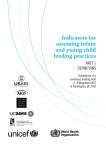 Indicators for assessing infant and young child feeding practices include 8 core indicators and 7 optional indicators, are population-based and can be derived from household survey data.
Indicators for assessing infant and young child feeding practices include 8 core indicators and 7 optional indicators, are population-based and can be derived from household survey data.
The indicators are the result of a consensus meeting held in Washington DC, USA, 6-8 November 2007. Developments in knowledge and recommendations in this area prompted the revision and expansion of the indicators which had been developed earlier for breastfeeding (1991) and for complementary feeding (2002).
Indicators for care for child development
 A set of indicators for care for child development has been developed to assess the status and quality of implementation of the intervention - including inputs, health providers’ performance and caregivers’ practices, and its impact.
A set of indicators for care for child development has been developed to assess the status and quality of implementation of the intervention - including inputs, health providers’ performance and caregivers’ practices, and its impact.
“Countdown to 2015” indicators and profiles
 The “Countdown to 2015” initiative collects indicators on key maternal, neonatal and child interventions to reduce maternal and child mortality, in line with the related Millennium Development Goals, in 75 countries which represent 95% of all maternal, neonatal and child mortality.
The “Countdown to 2015” initiative collects indicators on key maternal, neonatal and child interventions to reduce maternal and child mortality, in line with the related Millennium Development Goals, in 75 countries which represent 95% of all maternal, neonatal and child mortality.
Impact and coverage indicators across the continuum of care are presented in graphs as country profiles.
Core indicators by the Commission on information and accountability for Women’s and Children’s Health
 The Commission, in its report “Keeping promises, measuring results”, has selected a core of 11 indicators on maternal, neonatal and child health, aligned with the indicators of the Millennium Development Goals and with the continuum of care for maternal, newborn, and child health.
The Commission, in its report “Keeping promises, measuring results”, has selected a core of 11 indicators on maternal, neonatal and child health, aligned with the indicators of the Millennium Development Goals and with the continuum of care for maternal, newborn, and child health.
The indicators include three impact indicators and eight coverage indicators.
Impact indicators on the health status of women’s and children’s health.
- Maternal mortality ratio (deaths per 100 000 live births);
- Underfive child mortality, with the proportion of newborn deaths (deaths per 1000 live births);
- Children under five who are stunted (percentage of children under five years of age whose height-for-age is below minus two standard deviations from the median of the WHO Child Growth Standards).
Coverage indicators on key interventions on women’s and children’s health.
- Met need for contraception (proportion of women aged 15-49 years who are married or in union and who have met their need for family planning, i.e. who do not want any more children or want to wait at least two years before having a baby, and are using contraception);
- Antenatal care coverage (percentage of women aged 15–49 with a live birth who received antenatal care by a skilled health provider at least four times during pregnancy);
- Antiretroviral prophylaxis among HIV-positive pregnant women to prevent vertical transmission of HIV, and antiretroviral therapy for women who are treatment-eligible;
- Skilled attendant at birth (percentage of live births attended by skilled health personnel);
- Postnatal care for mothers and babies (percentage of mothers and babies who received postnatal care visit within two days of childbirth);
- Exclusive breastfeeding for six months (percentage of infants aged 0–5 months who are exclusively breastfed);
- Three doses of the combined diphtheria, pertussis and tetanus vaccine (percentage of infants aged 12–23 months who received three doses of diphtheria/pertussis/tetanus vaccine);
- Antibiotic treatment for pneumonia (percentage of children aged 0–59 months with suspected pneumonia receiving antibiotics).


